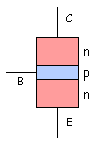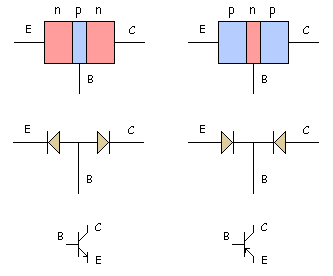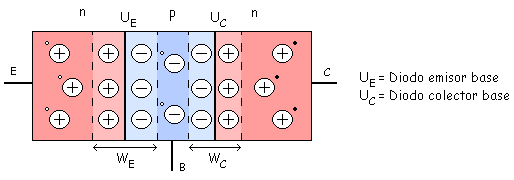- a gain of 10 una ganancia de 10
- 50 K Ω or higher input impedance 50 K Ω o mayor impedancia de entrada
- 50 Ω or lower output impedance 50 Ω o menor impedancia de salida
- Low freq response : 20 hz Baja Frecuencia de respuesta: 20 Hz
- High freq response : 100khz. Alta Frecuencia de respuesta: 100kHz.
Required: Requerido:
Design an amplifier using BJTs Diseñar un amplificador con BJT
The amplifier must have: El amplificador debe tener:
- a gain of 10 una ganancia de 10
- 50 K Ω or higher input impedance 50 K Ω o mayor impedancia de entrada
- 50 Ω or lower output impedance 50 Ω o menor impedancia de salida
- Low freq response: 20 hz Baja Frecuencia de respuesta: 20 Hz
- High freq response: 100khz Alta Frecuencia de respuesta: 100kHz
1) Use Standard Resistor Values 1) Utilice los valores estándar de resistencia
We are going to use two stages for the amplifier , a common emitter stage followed by a common collector stage. Vamos a utilizar dos etapas para el amplificador, una etapa en emisor común seguida por una etapa de colector común.
Assuming β = 300, Vbe = 0.7 V, Vcc = 15 V Suponiendo que β = 300, VBE = 0,7 V, Vcc = 15 V
Common Collector Stage Etapa colector común
Let Rc2 = 2.2K Ω, Re2 = 2.2K Ω, VceQ = 7.5 V Que Tc2 = 2,2 K Ω, RE2 = 2,2 K Ω, VceQ = 7,5 V
Let R3//R4 = Rth = 60 Ω Que R3 / / R4 Rth = = 60 Ω
Solving for R3 & R4 Resolviendo para R3 y R4
R3 = 188K Ω , R4 = 88K Ω R3 = 188K Ω, R4 = 88K Ω
Using standard resistor values Utilizando los valores estándar de resistencia
R3 = 220K Ω , R4 = 100K Ω R3 = 220K Ω, R4 = 100K Ω
Rth(new) = 68.75K Ω Rth (nuevo) = 68.75K Ω
The Ac Equivalent Circuit El circuito equivalente de ac
Rout: omitting the output resistance of the first stage Ruta: la omisión de la resistencia de salida de la primera etapa
Which is less than 50 Ω ¿Cuál es inferior a 50 Ω
2) Common Emitter Stage 2) Etapa en emisor común
This stage must have a gain = 10, and input impedance ≥ 50KΩ Esta etapa debe tener una ganancia = 10, y la impedancia de entrada ≥ 50KΩ
A rough approximation for the gain ≈ Rc1/Re1 Una aproximación a la ganancia ≈ Rc1/Re1
Let Rc1= 10KΩ, Re1 = 820Ω , VceQ = 7.5 V Que Rc1 = 10KΩ, Te1 = 820Ω, VceQ = 7,5 V
The Ac Equivalent Circuit El circuito equivalente de ac
We want Rin ≥ 50KΩ Queremos Rin ≥ 50KΩ
Rin = Rth // Rib Rin = Rth / / Rib
50K = Rth // 258K 50K = Rth / / 258k
Solving for Rth Despejando Rth
Rth = 62KΩ Rth = 62KΩ
Solving for R3 & R4 Resolviendo para R3 y R4
R1 = 658K Ω , R2 = 68K Ω R1 = 658K Ω, R2 = 68 K Ω
Using standard resistor values Utilizando los valores estándar de resistencia
R1 = 470K Ω + 220K Ω = 690K Ω , R2 = 68K Ω R1 = 470K + 220K Ω Ω = 690K Ω, R2 = 68 K Ω
Rout = Rc1 = 10K Ω Ruta = = 10K Ω Rc1
3) Frequency Response 3) Frecuencia de respuesta
Fl = 20 Hz , Fh = 100KHz Fl = 20 Hz, Fh = 100KHz
Using standard capacitor values Utilizando los valores estándar de condensadores
C1 = 0.16 μF, C2 = 0.12 μF, C3 = 0.033 μF C1 = 0,16 uF, C2 = 0,12 mF, C3 = 0,033 mF
4) Simulation 4) Simulación
Which shows that VceQ 1 = 8.125 – 0.566 = 7.559 V Lo que demuestra que VceQ 1 = 8,125-0,566 = 7,559 V
VceQ 2 = 11.354 – 3.658 = 7.696 V VceQ 2 = 11,354 a 3,658 = 7,696 V
ELABORADO POR:
NERWIN ANTONIO MORA REINOSO
C.I: 17.557.095
EES
SECCION 1



























